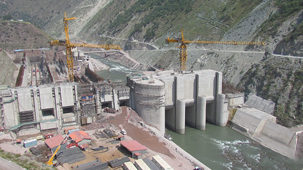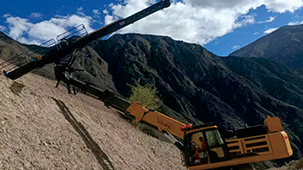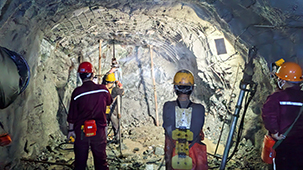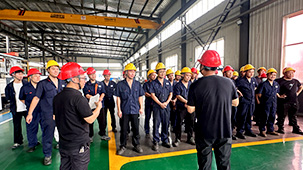Common quality problems in rock bolts construction
Time:2024-04-19From:sinorock View:
Introduction
Rock bolts are essential elements in stabilizing rock masses in various construction and mining projects. They provide crucial support by reinforcing fractured or unstable rock formations. However, ensuring the effectiveness and reliability of rock bolts involves addressing common quality issues that can compromise their performance and the safety of construction projects. So it is very important to ensure the construction quality of rock bolts.
Understanding Rock Bolts
- Definition and Purpose: Rock bolts are structural elements inserted into rock formations to provide reinforcement and stability. They transfer load from the unstable rock mass to the more competent surrounding rock.
- Types of Rock Bolts: There are various types, including inflatable and grouted rock bolts, each suited for different geological conditions and project requirements.
- Factors Influencing Performance: Several factors, such as rock type, bolt length and diameter, grouting material, and installation technique, influence the performance and effectiveness of rock bolts.
Common Quality Problems
1. The water cement ratio is not correct and cement dosage is insufficient. Field testers and supervisors should often measure the consistency of cement slurry to avoid the problem of less cement, caking or uneven mixing.
2. Rock bolt is set at a horizontal Angle. Due to most rock bolts are set up using drilling rigs. The direction of the drilling rig cannot be adjusted, and the rock drill is often pushed against the drill rig platform. Mean time, rock bolt above the arch shoulder is easy to be made into a horizontal angle, and cannot be made vertical with the excavation contour line, which makes the phenomenon of roof leakage in the arch part very common.
3. The positioning deviation of rock bolt is large and the hole forming depth is insufficient. Construction workers by intuition, not in accordance with the provisions of the line, marking, fixed point, resulting in large deviation hole position. Spot check should be random, the frequency is not less than 10% of the rock bolt total number.

4. The number of anchor rods is insufficient. A check should be made before grouting of rock bolt, and a check again after all grouting is completed. Finally, construction workers should be counted again before the initial spray. The site manager must be familiar with the design drawings and the number of rock bolts to be set in each cycle.
5. No grouting or not full grouting. Non-grouting means inserting the anchoring agent into the grouting port of rock bolt, resulting in a false grouting phenomenon. Check whether there is grouting overflow around the stop plug of the orientation, or judge whether the grouting has been done by tapping the rod body through sound. Grouting is not full mainly stop grouting plug is not tight, resulting in a too large pore, insufficient pressure. Or stop grouting, the anchor port is not blocked in time, resulting in cement slurry backflow.
Best Practices for Quality Assurance
- Pre-installation Inspections: Conduct thorough geological assessments and site inspections to identify potential challenges and determine appropriate rock bolt specifications.- Quality Control During Installation: Implement stringent quality control measures during installation, including monitoring grouting procedures, verifying tensioning, and conducting post-installation inspections.
- Post-installation Monitoring and Maintenance: Establish regular inspection and maintenance schedules to monitor the condition of rock bolts, detect any signs of deterioration or damage, and implement timely repairs or replacements.
Conclusion
Ensuring the quality and reliability of rock bolts in construction projects is paramount for maintaining the stability and safety of rock masses. By understanding common quality problems during the construction of rock bolts, and implementing best practices for quality assurance, construction professionals can mitigate risks and enhance the performance of rock bolt systems. Continuous monitoring, maintenance, and adherence to established standards are essential for achieving optimal outcomes in rock bolt construction.
latest news
-

- What Are the Applications of SDA Bolts in Hydropower Stations?
- Time:2025-08-21From:This Site
- Learn how self-drilling anchor bolts enhance slope stability, tunnel support, and dam reinforcement in complex geological conditions at hydropower stations. Optimize hydropower projects with efficient, cost-effective, and eco-friendly solutions.
- View details
-

- Slope Stabilization with SDA Bolts: Benefits & Applications
- Time:2025-08-19From:This Site
- Discover how self-drilling anchor bolts (SDA bolts) provide superior slope stabilization for highways, railways, and tunnels. Learn their key benefits, installation process, and real-world applications in loose or collapsible soils.
- View details
-

- How Self-Drilling Rock Bolts Enhance Tunnel Support in Fractured Rock?
- Time:2025-08-15From:This Site
- Discover how self-drilling rock bolts enhance tunnel support in fractured rock. Learn their benefits, installation steps, and real-world applications for safe, efficient tunneling.
- View details
-

- Sinorock 2025 Quality Month | Strengthening Quality Foundations, Empowering Product Excellence
- Time:2025-08-13From:This Site
- Sinorock’s 2025 Quality Month, themed “Strengthening Quality Foundations, Empowering Product Excellence,” successfully concluded, reinforcing our commitment to superior product quality.
- View details
-

- Sinorock Safety Month 2025 | Everyone Speaks Safety, Everyone Can Respond
- Time:2025-07-03From:This Site
- Sinorock Safety Month 2025, centered on the theme "Everyone Speaks Safety, Everyone Can Respond - Spot Workplace Hazards," has wrapped up successfully!
- View details
-

- Quality Control: the Vital Factor of A SDA Bolt Factory
- Time:2025-01-09From:This Site
- Sinorock’s comprehensive quality control system, from supplier management to outgoing inspections, ensuring the highest standards for self-drilling anchor bolts in construction.
- View details
-

- Sinorock Invites You to Explore Proven Self-Drilling Anchor Bolt Solutions at bauma 2025
- Time:2025-03-07From:This Site
- From April 7–13, 2025, explore Sinorock’s Self-drilling anchor bolt solution at Booth C2.513/4 in Hall C2 of the Messe München Exhibition Center (Munich, Germany).
- View details
-
.jpg)
- SINOROCK to Attend EXPOMINA PERÚ 2024 in Lima, Peru
- Time:2024-08-10From:This Site
- Sinorock to Attend EXPOMINA PERÚ 2024 in Lima, Peru
- View details
-
.jpg)
- SINOROCK to Participate in MINING AND METALS CENTRAL ASIA 2024
- Time:2024-08-08From:This Site
- SINOROCK to Participate in MINING AND METALS CENTRAL ASIA 2024
- View details
 Download
Download 


